MCAT Exam > MCAT Notes > Biology for MCAT > Passive Transport and Active Transport across a Cell Membrane
Passive Transport and Active Transport across a Cell Membrane | Biology for MCAT PDF Download
| Table of contents |

|
| Transport Across a Cell Membrane |

|
| Semi-Permeability |

|
| Movement Across a Membrane and Energy |

|
| Diffusion: the Simple and the Facilitated |

|
| Active Transport |

|
Transport Across a Cell Membrane
The cell membrane is a versatile component of biology, serving multiple functions. It provides support and structure to the cell, safeguards the contents within the cytoplasm from the external environment, and enables cells to carry out specialized functions. Serving as the cell's interface with the outside world, the membrane acts as a gatekeeper, regulating the movement of molecules into and out of the cell. As a result, it plays a crucial role in maintaining the precise balance and stability, known as homeostasis, within each cell.
Semi-Permeability
- The pH preferences of cells vary, with some functioning optimally at pH 5 and others at pH 7. The adrenal gland produces aldosterone, a steroid hormone that primarily affects the kidney. Sodium concentration is more than ten times higher outside cells compared to inside. Without the ability to control the passage of molecules across their membranes, cells would either experience a lack of molecular movement or face chaotic and constant fluctuations in their internal environment. This would be akin to blending together all items on a menu before serving, resulting in an unfavorable outcome.
- To maintain distinct concentrations of proteins and molecules despite the tendency towards homogeneity, cells employ semipermeable membranes. These membranes possess the ability to regulate the passage of molecules, allowing some to freely diffuse while requiring specialized structures or energy assistance for others to traverse the cell membrane. Each cell's membrane is equipped with the appropriate combination of these structures to ensure the maintenance of its internal environment within the desired range.
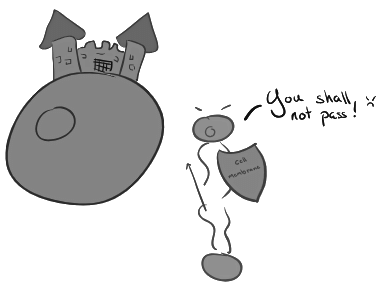
Movement Across a Membrane and Energy
Molecules can be transported across a membrane through two primary mechanisms, which differ based on the involvement of cellular energy. Passive mechanisms, such as diffusion, occur without the expenditure of energy, while active transport relies on energy to accomplish the process.
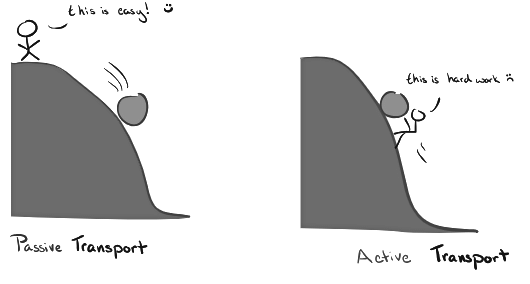
Diffusion: the Simple and the Facilitated
Diffusion refers to the movement of particles along their concentration gradient. A concentration gradient refers to an uneven distribution of particles, and when particles move down the gradient, they are attempting to achieve an equal distribution throughout the system, similar to the way food coloring spreads in water. This process can be observed when combining various ingredients to make granola, as the individual components disperse and evenly distribute within the mixture. We describe this movement towards equilibrium as "moving downhill," and it does not require energy expenditure. Water is a molecule that is highly likely to participate in simple diffusion, as it can easily traverse cell membranes. When water undergoes simple diffusion, it is commonly referred to as osmosis.
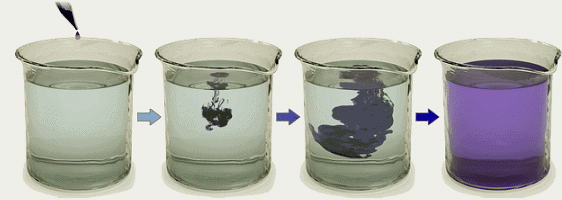
- Simple diffusion refers to the straightforward movement of molecules down their concentration gradients across the cell membrane. In order to undergo simple diffusion, molecules must meet certain criteria: they need to be small in size and nonpolar, allowing them to freely pass through the membrane. However, if the distance for diffusion is increased, such as in cases of pulmonary edema where fluid fills the lung alveoli, the transportation of gases is hindered.
- On the other hand, facilitated diffusion involves the assistance of membrane transport channels to facilitate the movement of molecules across the membrane. These channels, composed of glycoproteins with attached carbohydrates, serve as pathways for molecules to pass through. These channels are often specific to particular molecules or types of molecules, such as ion channels, and are closely associated with specific physiological functions.
- For instance, GLUT4 is a crucial glucose transporter found in fat and skeletal muscle cells, playing a vital role in diabetes. When triggered by insulin, GLUT4 is inserted into the cell membranes, enabling the uptake of glucose from the bloodstream. As facilitated diffusion is a passive process, the amount of sugar entering our cells is proportional to the amount of sugar consumed until the saturation point is reached, where all available channels are utilized.
- However, in type II diabetes mellitus, cells exhibit reduced responsiveness to insulin, leading to the inadequate insertion of GLUT4 into their membranes. This can result in elevated blood glucose levels, which can contribute to the development of heart disease, stroke, and kidney failure.
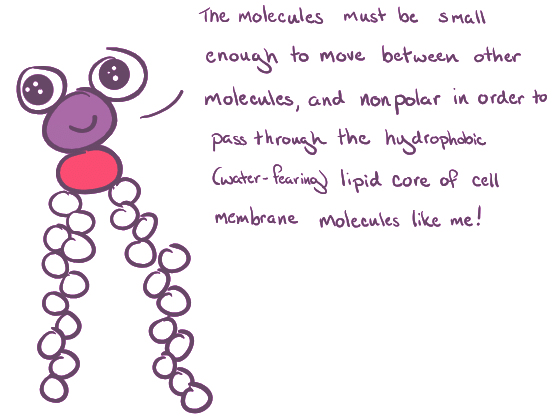
Active Transport
In certain situations, the body needs to transport molecules against their concentration gradients, which is referred to as moving "uphill."
- This process requires energy from the cell, similar to how it would be more challenging to separate the components of trail mix once they are shaken together. An example of uphill transport is demonstrated by the sodium-potassium pump (Na+/K+ ATPase), which plays a vital role in maintaining the resting potential of the cell.
- This protein utilizes the energy released from the hydrolysis of ATP (adenosine triphosphate) to actively transport three sodium ions out of the cell and two potassium ions into the cell. ATP serves as an energy molecule, and its hydrolysis results in the release of stored energy from its chemical bonds. This type of transport, which directly utilizes ATP for energy, is known as primary active transport.
- In this case, sodium is being moved from a concentration of 10 mM to 145 mM, and a similar concentration gradient is overcome for potassium, with intracellular and extracellular concentrations of 140 mM and 5 mM, respectively. These types of transporters that require significant energy are relatively rare due to their high energy cost. Another example of an ATP pump is the proton/potassium exchanger (H+/K+ ATPase) found in the stomach.
- These proton pumps are responsible for creating the acidic environment in the stomach and can contribute to acid reflux. Proton pump inhibitors like omeprazole are prescribed to patients with ulcers or acid reflux to help reduce the acidity of the gastrointestinal tract.

- The sodium-potassium pump involves transmembrane channels that enable the flow of ions down their respective gradients.
- In secondary active transport, multiple molecules are transported across the membrane, with the uphill movement of one molecule (A) powered by the downhill movement of another molecule(s) (B). For instance, SGLT2 is a glucose transporter that facilitates the entry of glucose (Molecule A) into our cells against its concentration gradient by simultaneously bringing in a sodium ion (Molecule B). Since both molecules move in the same direction, this type of transporter is called a symporter. On the other hand, antiporters are proteins that allow molecules to move in opposite directions. A notable example is the sodium/calcium exchanger, which restores calcium concentrations in cardiomyocytes (heart cells) after an action potential. The antiporter expels calcium (Molecule A) against its concentration gradient while simultaneously transporting a sodium ion (Molecule B) to promote heart relaxation.
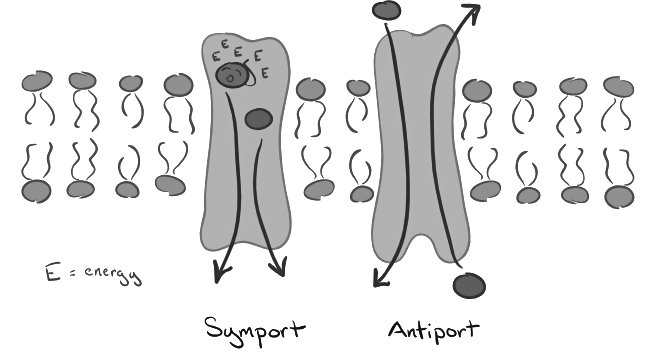
- Many secondary active transporters utilize sodium to drive the movement of other molecules against their concentration gradients. This reliance on sodium is closely tied to the significance of the sodium-potassium pump, as it establishes the necessary gradient for the transportation of various substances into and out of the cell. This relationship is exploited in certain medications used for heart disease treatment. For example, digoxin is prescribed to patients with atrial fibrillation, an abnormal and rapid heart rate. Digoxin works by inhibiting the sodium-potassium pump, resulting in the accumulation of intracellular sodium. Surprisingly, this accumulation causes the sodium-calcium pump to reverse its direction. As a result, sodium is pumped out of the cell, while calcium is brought into the cell, leading to stronger heart contractions.
The document Passive Transport and Active Transport across a Cell Membrane | Biology for MCAT is a part of the MCAT Course Biology for MCAT.
All you need of MCAT at this link: MCAT
|
233 videos|16 docs|32 tests
|
Related Searches




















